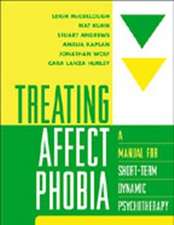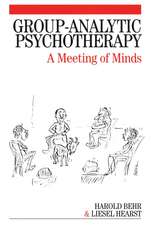Psychodynamic Group Psychotherapy, Fifth Edition
Autor J. Scott Rutan, Walter N. Stone, Joseph J. Shayen Limba Engleză Hardback – 8 aug 2014
Regarded as the definitive practitioner reference and text, this accessible work addresses how to set up therapy groups and make them work. A wealth of clinical material illustrates the components of effective group therapy and the mechanisms and processes of change. Practical topics discussed include patient selection and preparation, leadership issues, communication of affect in groups, dealing with difficult patients, time-limited groups, and facilitating successful terminations. A chapter-length case example with commentary from each author brings an entire group session to life and explores ways to handle common dilemmas.
New to This Edition
*Incorporates current theory (psychodynamic and interpersonal), and supporting clinical and neurobiological research.
*Every chapter revised and updated.
*Chapter-length case example is entirely new.
*Chapter on Frequently Asked Questions includes many new issues.
New to This Edition
*Incorporates current theory (psychodynamic and interpersonal), and supporting clinical and neurobiological research.
*Every chapter revised and updated.
*Chapter-length case example is entirely new.
*Chapter on Frequently Asked Questions includes many new issues.
Preț: 442.22 lei
Preț vechi: 465.50 lei
-5% Nou
Puncte Express: 663
Preț estimativ în valută:
84.65€ • 91.97$ • 71.15£
84.65€ • 91.97$ • 71.15£
Carte disponibilă
Livrare economică 31 martie-14 aprilie
Livrare express 15-21 martie pentru 43.13 lei
Preluare comenzi: 021 569.72.76
Specificații
ISBN-13: 9781462516506
ISBN-10: 1462516505
Pagini: 465
Dimensiuni: 152 x 229 x 38 mm
Greutate: 0.77 kg
Ediția:5 Rev ed.
Editura: Guilford Publications
Colecția Guilford Press
ISBN-10: 1462516505
Pagini: 465
Dimensiuni: 152 x 229 x 38 mm
Greutate: 0.77 kg
Ediția:5 Rev ed.
Editura: Guilford Publications
Colecția Guilford Press
Public țintă
Postgraduate, Professional, and UndergraduateCuprins
1. Groups in Today’s Society
2. History of Small-Group Theory and Practice
3. Group Dynamics and Group Development
4. Therapeutic Factors in Group Psychotherapy
5. Mechanisms and Processes of Change
6. Forming a Group
7. Patient Selection
8. Patient Preparation and the Group Agreements
9. The Role of the Group Therapist
10. Beginning the Group
11. Special Leadership Issues
12. Expressions of Affect in Group Psychotherapy
13. The Therapeutic Process: A Clinical Illustration
14. Difficult Groups and Difficult Patients
15. Time-Limited Psychodynamic Groups
16. Termination in Group Psychotherapy
17. Frequently Asked Questions
References
Author Index
Subject Index
Notă biografică
J. Scott Rutan, PhD, is a psychologist in private practice in Chestnut Hill, Massachusetts. He is a Distinguished Fellow and past president of the American Group Psychotherapy Association (AGPA) and a Certified Group Psychotherapist. Dr. Rutan was the founder of the Center for Group Psychotherapy at Massachusetts General Hospital/Harvard Medical School and cofounder of the Boston Institute for Psychotherapy. He has published widely on group therapy and psychodynamic theory, conducts workshops around the world, and serves on the editorial boards of several journals.
Walter N. Stone, MD, is Professor Emeritus of Psychiatry at the University of Cincinnati College of Medicine and currently consults and teaches in Northern California. A Distinguished Fellow and past president of the AGPA and a Certified Group Psychotherapist, Dr. Stone has served as a board member and treasurer of the International Association for Group Psychotherapy and Group Processes. He has published widely on self psychological perspectives in group psychotherapy.
Joseph J. Shay, PhD, is a psychologist in private practice in Cambridge, Massachusetts. He is on the staff of the joint McLean/Massachusetts General Hospital (MGH) training program and has an appointment in the Department of Psychiatry at Harvard Medical School. He also serves on the faculties of the Northeastern Society for Group Psychotherapy, the Psychoanalytic Couple and Family Institute of New England, and the MGH Center for Psychodynamic Therapy and Research. A Fellow of the AGPA and a Certified Group Psychotherapist, Dr. Shay is a recipient of the Psychotherapy Supervision Award from the McLean/MGH residents in Adult Psychiatry. He has published widely on group therapy and couple therapy and serves on the editorial board of the International Journal of Group Psychotherapy.
Walter N. Stone, MD, is Professor Emeritus of Psychiatry at the University of Cincinnati College of Medicine and currently consults and teaches in Northern California. A Distinguished Fellow and past president of the AGPA and a Certified Group Psychotherapist, Dr. Stone has served as a board member and treasurer of the International Association for Group Psychotherapy and Group Processes. He has published widely on self psychological perspectives in group psychotherapy.
Joseph J. Shay, PhD, is a psychologist in private practice in Cambridge, Massachusetts. He is on the staff of the joint McLean/Massachusetts General Hospital (MGH) training program and has an appointment in the Department of Psychiatry at Harvard Medical School. He also serves on the faculties of the Northeastern Society for Group Psychotherapy, the Psychoanalytic Couple and Family Institute of New England, and the MGH Center for Psychodynamic Therapy and Research. A Fellow of the AGPA and a Certified Group Psychotherapist, Dr. Shay is a recipient of the Psychotherapy Supervision Award from the McLean/MGH residents in Adult Psychiatry. He has published widely on group therapy and couple therapy and serves on the editorial board of the International Journal of Group Psychotherapy.
Recenzii
"A comprehensive source for all aspects of group psychotherapy. Topics range from nuts-and-bolts issues like getting groups under way to substantial discussions of group development and dynamics, including ideas from attachment and mentalization theory. This is a book that will be of great interest to students just beginning clinical work, early-career professionals, and senior psychoanalytic psychologists who wish to improve and refresh their skills."--Elliot Jurist, PhD, Professor of Psychology and Philosophy, The Graduate Center and the City College of New York, City University of New York
"Since the publication of the first edition, this wonderful book has been the most valuable single volume on psychodynamic group therapy. Our culture has changed at a staggering rate; the fifth edition takes into account the impact of social media, public policy, and neuroscience research, bringing the field up to the moment. This book belongs in the library of every therapist, from beginning student to seasoned clinician."--Hillel I. Swiller, MD, Director, Division of Psychotherapy, Mount Sinai School of Medicine
"A 'must' for those learning the basics of group therapy and for experienced clinicians seeking to integrate contemporary developmental theories, neurobiological findings, and sophisticated group interventions. The authors emphasize dynamic approaches, but all group leaders, regardless of orientation, can benefit. Readers will learn how interpersonal difficulties develop and how group therapy has the potential to change lifelong perceptions of self and others and alleviate human suffering. I have used this text for over 10 years in my graduate courses; the fifth edition includes recent research findings, additional dynamic approaches to group treatment, and new clinical vignettes. It is a true gem that I will continue to rely on for training the next generation of group therapists."--Cheri L. Marmarosh, PhD, Professional Psychology Program, The George Washington University
"I have used Psychodynamic Group Psychotherapy in teaching and find it to be a valuable resource to help graduate-level trainees gain a good grasp of group dynamics. Nuanced and yet succinct, the book elucidates the fundamentals of group functioning and equips the future practitioner to create an environment in which group members can connect with others in healing and meaningful ways. The fifth edition draws on contemporary research and neurobiology to demonstrate that human, face-to-face interaction is still necessary for creating well-being, even in our era of proliferating technology."--Alexandra Watkins, LMHC, CPRP, Adjunct Faculty, Counseling and Psychology Department, Lesley University
-Very informative for the beginning group therapist. The book was especially helpful because of its broad-based approachwith a number of theoretical perspectives considered to further the understanding and integration necessary in exploratory therapy. The eclectic stance was a change from other models of exploratory group therapy frequently taught in training programs. I would recommend this book to any psychiatry resident interested in becoming a group therapist. (on the fourth edition)--Psychiatry: Interpersonal and Biological Processes, 1/24/2014ƒƒThe writing is clear and clean....That this excellence is maintained throughout a book by three different authors is a tribute to the quality of the collaboration. Difficult concepts are explained well and in depth, but without oversimplification. Clinical examples are used copiously throughout and invariably richly illustrate the point under discussion....A particular strength (and remarkable achievement) of the book is that it offers something for everyone, from the novice to the highly experienced....An essential part of the library of every group psychotherapist. (on the fourth edition)--International Journal of Group Psychotherapy, 7/1/2008ƒƒPresents a cohesive theoretical framework for the practice of group psychotherapy from a psychodynamic framework....The authors have succeeded nicely in unifying a complicated field without resorting to oversimplification....Fills an important niche and is unique in many ways. Without sacrificing intellectual clarity, it unifies and organizes the theory that underlies psychodynamic group psychotherapy....I highly recommend it. (on the second edition)--Doody's Review Service, 1/23/2014ƒƒ[The authors] have drawn from their vast experience to put together what is probably the best available book on psychodynamic group psychotherapy….The book should continue to be widely used as a basic text for teaching psychodynamic group psychotherapy. (on the second edition)--Psychiatric Services, 5/1/1995"Since the publication of the first edition, this wonderful book has been the most valuable single volume on psychodynamic group therapy. Our culture has changed at a staggering rate; the fifth edition takes into account the impact of social media, public policy, and neuroscience research, bringing the field up to the moment. This book belongs in the library of every therapist, from beginning student to seasoned clinician."--Hillel I. Swiller, MD, Director, Division of Psychotherapy, Mount Sinai School of Medicine
"A 'must' for those learning the basics of group therapy and for experienced clinicians seeking to integrate contemporary developmental theories, neurobiological findings, and sophisticated group interventions. The authors emphasize dynamic approaches, but all group leaders, regardless of orientation, can benefit. Readers will learn how interpersonal difficulties develop and how group therapy has the potential to change lifelong perceptions of self and others and alleviate human suffering. I have used this text for over 10 years in my graduate courses; the fifth edition includes recent research findings, additional dynamic approaches to group treatment, and new clinical vignettes. It is a true gem that I will continue to rely on for training the next generation of group therapists."--Cheri L. Marmarosh, PhD, Professional Psychology Program, The George Washington University
"I have used Psychodynamic Group Psychotherapy in teaching and find it to be a valuable resource to help graduate-level trainees gain a good grasp of group dynamics. Nuanced and yet succinct, the book elucidates the fundamentals of group functioning and equips the future practitioner to create an environment in which group members can connect with others in healing and meaningful ways. The fifth edition draws on contemporary research and neurobiology to demonstrate that human, face-to-face interaction is still necessary for creating well-being, even in our era of proliferating technology."--Alexandra Watkins, LMHC, CPRP, Adjunct Faculty, Counseling and Psychology Department, Lesley University
Descriere
Regarded as the definitive practitioner reference and text, this accessible work addresses how to set up therapy groups and make them work. A wealth of clinical material illustrates the components of effective group therapy and the mechanisms and processes of change. Practical topics discussed include patient selection and preparation, leadership issues, communication of affect in groups, dealing with ""difficult"" patients, time-limited groups, and facilitating successful terminations. A chapter-length case example with commentary from each author brings an entire group session to life and explores ways to handle common dilemmas.












